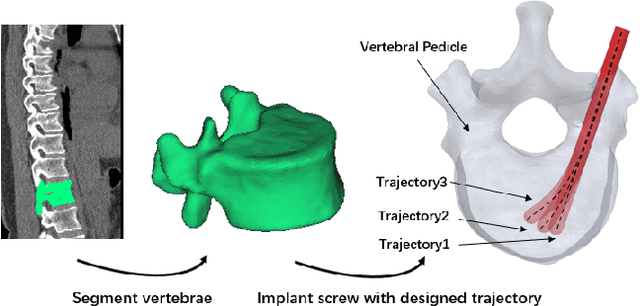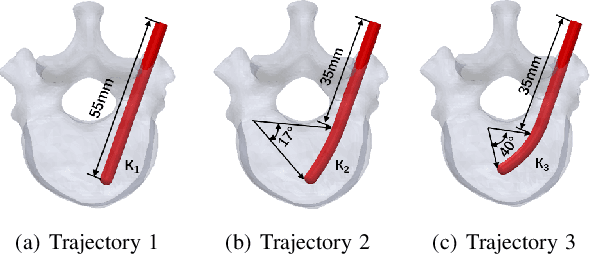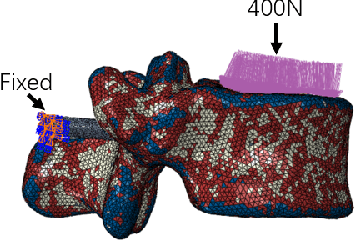Susheela Sharma
From Monocular Vision to Autonomous Action: Guiding Tumor Resection via 3D Reconstruction
Mar 20, 2025Abstract:Surgical automation requires precise guidance and understanding of the scene. Current methods in the literature rely on bulky depth cameras to create maps of the anatomy, however this does not translate well to space-limited clinical applications. Monocular cameras are small and allow minimally invasive surgeries in tight spaces but additional processing is required to generate 3D scene understanding. We propose a 3D mapping pipeline that uses only RGB images to create segmented point clouds of the target anatomy. To ensure the most precise reconstruction, we compare different structure from motion algorithms' performance on mapping the central airway obstructions, and test the pipeline on a downstream task of tumor resection. In several metrics, including post-procedure tissue model evaluation, our pipeline performs comparably to RGB-D cameras and, in some cases, even surpasses their performance. These promising results demonstrate that automation guidance can be achieved in minimally invasive procedures with monocular cameras. This study is a step toward the complete autonomy of surgical robots.
Towards the Feasibility Analysis and Additive Manufacturing of a Novel Flexible Pedicle Screw for Spinal Fixation Procedures
Sep 16, 2024Abstract:In this paper, we explore the feasibility of developing a novel flexible pedicle screw (FPS) for enhanced spinal fixation of osteoporotic vertebrae. Vital for spinal fracture treatment, pedicle screws have been around since the early 20th century and have undergone multiple iterations to enhance internal spinal fixation. However, spinal fixation treatments tend to be problematic for osteoporotic patients due to multiple inopportune variables. The inherent rigid nature of the pedicle screw, along with the forced linear trajectory of the screw path, frequently leads to the placement of these screws in highly osteoporotic regions of the bone. This results in eventual screw slippage and causing neurological and respiratory problems for the patient. To address this problem, we focus on developing a novel FPS that is structurally capable of safely bending to fit curved trajectories drilled by a steerable drilling robot and bypass highly osteoporotic regions of the vertebral body. Afterwards, we simulate its morphability capabilities using finite element analysis (FEA). We then additively manufacture the FPS using stainless steel (SS) 316L alloy through direct metal laser sintering (DMLS). Finally, the fabricated FPS is experimentally evaluated for its bending performance and compared with the FEA results for verification. Results demonstrate the feasibility of additive manufacturing of FPS using DMLS approach and agreement of the developed FEA with the experiments.
Towards an Autonomous Minimally Invasive Spinal Fixation Surgery Using a Concentric Tube Steerable Drilling Robot
May 29, 2024



Abstract:Towards performing a realistic autonomous minimally invasive spinal fixation procedure, in this paper, we introduce a unique robotic drilling system utilizing a concentric tube steerable drilling robot (CT-SDR) integrated with a seven degree-of-freedom robotic manipulator. The CT-SDR in integration with the robotic arm enables creating precise J-shape trajectories enabling access to the areas within the vertebral body that currently are not accessible utilizing existing rigid instruments. To ensure safety and accuracy of the autonomous drilling procedure, we also performed required calibration procedures. The performance of the proposed robotic system and the calibration steps were thoroughly evaluated by performing various drilling experiments on simulated Sawbone samples.
Towards Biomechanical Evaluation of a Transformative Additively Manufactured Flexible Pedicle Screw for Robotic Spinal Fixation
May 27, 2024Abstract:Vital for spinal fracture treatment, pedicle screw fixation is the gold standard for spinal fixation procedures. Nevertheless, due to the screw pullout and loosening issues, this surgery often fails to be effective for patients suffering from osteoporosis (i.e., having low bone mineral density). These failures can be attributed to the rigidity of existing drilling instruments and pedicle screws forcing clinicians to place these implants into the osteoporotic regions of the vertebral body. To address this critical issue, we have developed a steerable drilling robotic system and evaluated its performance in drilling various J- and U-shape trajectories. Complementary to this robotic system, in this paper, we propose design, additive manufacturing, and biomechanical evaluation of a transformative flexible pedicle screw (FPS) that can be placed in pre-drilled straight and curved trajectories. To evaluate the performance of the proposed flexible implant, we designed and fabricated two different types of FPSs using the direct metal laser sintering (DMLS) process. Utilizing our unique experimental setup and ASTM standards, we then performed various pullout experiments on these FPSs to evaluate and analyze their biomechanical performance implanted in straight trajectories.
Spatial Spinal Fixation: A Transformative Approach Using a Unique Robot-Assisted Steerable Drilling System and Flexible Pedicle Screw
May 27, 2024Abstract:Spinal fixation procedures are currently limited by the rigidity of the existing instruments and pedicle screws leading to fixation failures and rigid pedicle screw pull out. Leveraging our recently developed Concentric Tube Steerable Drilling Robot (CT-SDR) in integration with a robotic manipulator, to address the aforementioned issue, here we introduce the transformative concept of Spatial Spinal Fixation (SSF) using a unique Flexible Pedicle Screw (FPS). The proposed SSF procedure enables planar and out-of-plane placement of the FPS throughout the full volume of the vertebral body. In other words, not only does our fixation system provide the option of drilling in-plane and out-of-plane trajectories, it also enables implanting the FPS inside linear (represented by an I-shape) and/or non-linear (represented by J-shape) trajectories. To thoroughly evaluate the functionality of our proposed robotic system and the SSF procedure, we have performed various experiments by drilling different I-J and J-J drilling trajectory pairs into our custom-designed L3 vertebral phantoms and analyzed the accuracy of the procedure using various metrics.
A Patient-Specific Framework for Autonomous Spinal Fixation via a Steerable Drilling Robot
May 27, 2024Abstract:In this paper, with the goal of enhancing the minimally invasive spinal fixation procedure in osteoporotic patients, we propose a first-of-its-kind image-guided robotic framework for performing an autonomous and patient-specific procedure using a unique concentric tube steerable drilling robot (CT-SDR). Particularly, leveraging a CT-SDR, we introduce the concept of J-shape drilling based on a pre-operative trajectory planned in CT scan of a patient followed by appropriate calibration, registration, and navigation steps to safely execute this trajectory in real-time using our unique robotic setup. To thoroughly evaluate the performance of our framework, we performed several experiments on two different vertebral phantoms designed based on CT scan of real patients.
Towards Biomechanics-Aware Design of a Steerable Drilling Robot for Spinal Fixation Procedures with Flexible Pedicle Screws
May 24, 2023



Abstract:Towards reducing the failure rate of spinal fixation surgical procedures in osteoporotic patients, we propose a unique biomechanically-aware framework for the design of a novel concentric tube steerable drilling robot (CT-SDR). The proposed framework leverages a patient-specific finite element (FE) biomechanics model developed based on Quantitative Computed Tomography (QCT) scans of the patient's vertebra to calculate a biomechanically-optimal and feasible drilling and implantation trajectory. The FE output is then used as a design requirement for the design and evaluation of the CT-SDR. Providing a balance between the necessary flexibility to create curved optimal trajectories obtained by the FE module with the required strength to not buckle during drilling through a hard simulated bone material, we showed that the CT-SDR can reliably recreate this drilling trajectory with errors between 1.7-2.2%
A Novel Concentric Tube Steerable Drilling Robot for Minimally Invasive Treatment of Spinal Tumors Using Cavity and U-shape Drilling Techniques
May 24, 2023Abstract:In this paper, we present the design, fabrication, and evaluation of a novel flexible, yet structurally strong, Concentric Tube Steerable Drilling Robot (CT-SDR) to improve minimally invasive treatment of spinal tumors. Inspired by concentric tube robots, the proposed two degree-of-freedom (DoF) CT-SDR, for the first time, not only allows a surgeon to intuitively and quickly drill smooth planar and out-of-plane J- and U- shape curved trajectories, but it also, enables drilling cavities through a hard tissue in a minimally invasive fashion. We successfully evaluated the performance and efficacy of the proposed CT-SDR in drilling various planar and out-of-plane J-shape branch, U-shape, and cavity drilling scenarios on simulated bone materials.
 Add to Chrome
Add to Chrome Add to Firefox
Add to Firefox Add to Edge
Add to Edge